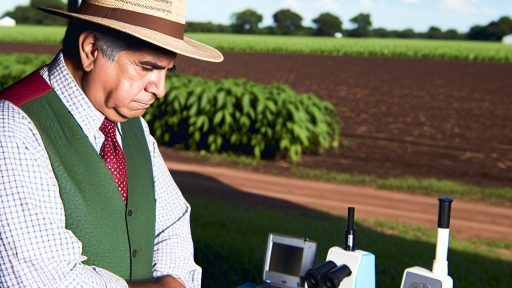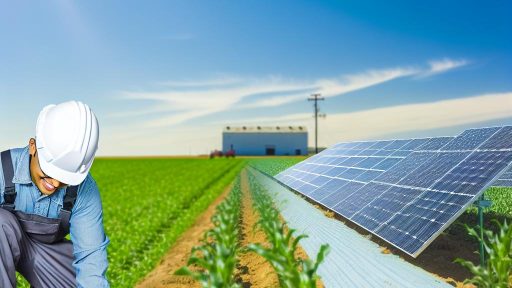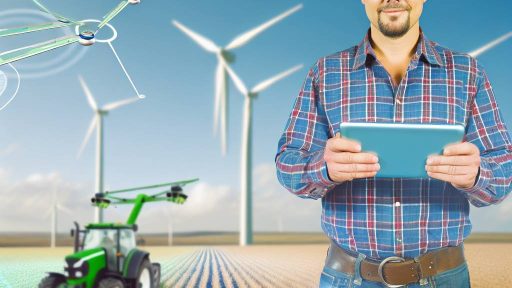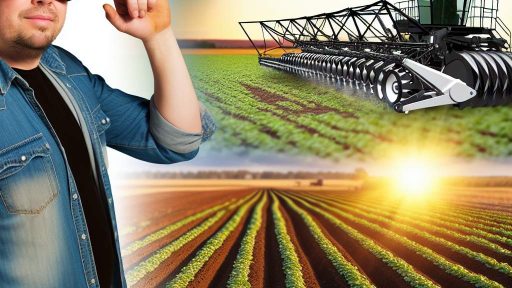Introduction to Automated Machinery in Agriculture
Agriculture faces challenges in meeting food demands today.
Automated machinery plays a crucial role in this landscape.
Farmers increasingly rely on technology for efficiency.
This mechanization transforms traditional farming methods significantly.
Benefits of Automation
Automated machinery improves precision in farming practices.
This precision leads to enhanced crop yields and reduced waste.
For instance, drones monitor crop health effectively.
Additionally, automated tractors optimize field operations.
Consequently, farmers save time and labor costs.
Role of Data and Technology
Data-driven insights guide farmers in decision-making processes.
Sensors collect real-time information from fields.
This information supports timely interventions and management strategies.
Moreover, predictive analytics enable better resource allocation.
Examples of Automated Machinery
Various types of machinery have emerged in modern agriculture.
- Robotic harvesters improve efficiency during peak seasons.
- Automated irrigation systems conserve water and reduce manual labor.
- Seeders equipped with GPS technology ensure precise planting.
These innovations showcase the evolution of farming practices today.
Transform Your Agribusiness
Unlock your farm's potential with expert advice tailored to your needs. Get actionable steps that drive real results.
Get StartedChallenges and Considerations
Despite their benefits, automated machinery presents challenges.
High initial costs can deter some farmers from adoption.
Additionally, technical skill gaps exist among workers.
Farmers must balance automation with traditional practices.
Overview of Crop Yield Improvements from Automation
Introduction to Automated Machinery
Automated machinery significantly transforms modern agriculture.
These innovations improve efficiency in various farming operations.
Farmers now rely on technology more than ever before.
Enhanced Precision in Farming
Automation increases the precision of planting and harvesting.
Machines can plant seeds at optimal depths and spacing.
This accuracy leads to better germination rates and crop health.
Additionally, automated systems allow for real-time adjustments.
Farmers can optimize resource use for maximum yield.
Reduced Labor Costs
Automation minimizes the reliance on manual labor.
This shift significantly reduces operational costs for farmers.
With fewer laborers needed, farms can save on wages and training.
Moreover, machinery operates continuously, increasing productivity.
Improved Data Collection and Analysis
Automated machinery often comes equipped with data collection tools.
These tools track growth patterns, soil health, and weather conditions.
Farmers can analyze this data to make informed decisions.
As a result, they can address issues promptly and effectively.
Benefits of Crop Monitoring Technologies
Monitoring technologies enhance early detection of plant diseases.
Timely interventions minimize losses and boost overall yield.
Furthermore, automated irrigation systems optimize water use.
This efficient water management supports healthier crops.
Showcase Your Farming Business
Publish your professional farming services profile on our blog for a one-time fee of $200 and reach a dedicated audience of farmers and agribusiness owners.
Publish Your ProfileCase Studies of Successful Implementation
Companies like AgriTech Innovations have seen remarkable results.
Their automated systems led to a 30% increase in yield.
Similarly, GreenFarm Solutions reported reduced costs and improved quality.
These case studies highlight the profound impact of automation.
Types of Automated Machinery Used in Agriculture
Precision Agriculture Equipment
Precision agriculture equipment optimizes field-level management.
It uses technology to analyze field variability.
Drones are a crucial component of precision agriculture.
They provide aerial imagery to assess crop health.
Additionally, satellite systems offer insights for better decision-making.
Automated Tractors
Automated tractors enhance efficiency in the field.
They perform various tasks such as planting and harvesting.
These machines often operate using GPS technology.
This leads to improved accuracy and reduced waste.
Robotic Harvesters
Robotic harvesters revolutionize fruit and vegetable picking.
They can work longer hours without fatigue.
These robots analyze ripeness to select the best produce.
As a result, they minimize damage to crops during harvesting.
Automated Irrigation Systems
Automated irrigation systems ensure optimal water usage.
They adjust watering schedules based on weather conditions.
This technology helps conserve water and improve crop yields.
Moreover, drip irrigation systems target water delivery precisely.
Soil Monitoring Sensors
Soil monitoring sensors play a vital role in farming.
These devices measure moisture levels and soil nutrients.
Farmers can make timely adjustments to enhance crop growth.
Additionally, they help in preventing over-fertilization.
See Related Content: Best Practices For Using Imaging Technology In Crop Disease Detection
Benefits of Precision Farming Technologies
Improved Resource Management
Precision farming technologies optimize resource use efficiently.
Farmers can apply water, fertilizers, and pesticides precisely.
This reduces waste and lowers operational costs significantly.
As a result, crops receive just what they need to thrive.
Moreover, technology helps farmers monitor soil health closely.
They can adjust practices based on real-time data.
Enhanced Crop Monitoring
Advanced sensors and drones enable better crop monitoring.
Farmers can identify pest infestations early and treat them promptly.
This proactive approach leads to higher crop yields overall.
Additionally, monitoring helps in managing crop diseases effectively.
Timely intervention minimizes crop losses and increases profitability.
Increased Efficiency
Automation in farming tasks boosts overall efficiency.
Machines can perform repetitive tasks swiftly and accurately.
This allows farmers to focus on strategic decision-making.
Showcase Your Farming Business
Publish your professional farming services profile on our blog for a one-time fee of $200 and reach a dedicated audience of farmers and agribusiness owners.
Publish Your ProfileFurthermore, automated machinery works tirelessly, even at night.
As a result, the farming cycle becomes faster and more efficient.
Data-Driven Decision Making
Data analytics plays a crucial role in precision farming.
Farmers can analyze trends and patterns effectively.
This insight helps in planning for future planting and harvesting.
With accurate data, farmers can make informed decisions swiftly.
Consequently, this leads to improved yield predictions and crop quality.
Environmental Benefits
Precision farming reduces the environmental footprint of agriculture.
By minimizing chemical runoff, it protects local ecosystems.
Additionally, efficient water use conserves this vital resource.
As a direct result, biodiversity in farming areas improves.
Farmers also contribute to sustainable practices and climate resilience.
Find Out More: Enhancing Food Safety With Blockchain In Agricultural Supply Chains
Impact of Drones on Crop Monitoring and Analysis
Enhanced Data Collection
Drones significantly improve data collection efficiency.
They capture detailed aerial images of crop fields.
Additionally, drones maintain consistency in data gathering.
Farmers can analyze the captured images using sophisticated software.
This software helps identify various crop health indicators.
Real-Time Monitoring
Drones provide real-time monitoring of crop conditions.
This capability allows farmers to detect problems early.
For instance, farmers can identify pest infestations quickly.
Thus, they can take immediate corrective actions.
As a result, crop losses due to late intervention decrease.
Precision Agriculture
Drones contribute to precision agriculture practices.
They enable targeted application of fertilizers and pesticides.
By assessing crop health, drones help optimize inputs.
This optimization leads to reduced costs and environmental impact.
Consequently, farmers enhance their overall productivity.
Improved Decision-Making
Data from drones supports better decision-making processes.
Farmers can analyze trends over time through drone data.
This analysis is crucial for planning future crop cycles.
Furthermore, accurate data allows for informed investment choices.
Ultimately, this leads to increased crop yields.
Case Studies in Drone Adoption
Many farmers have successfully adopted drone technology.
For example, Michael Jameson, a corn farmer, reports improved yields.
His drone usage allowed him to monitor his fields effectively.
Similarly, GreenMap Farms utilizes drones for their vineyard analysis.
They observe significant reductions in pesticide usage.
Learn More: Benefits Of Advanced Crop Disease Detection Technologies For Today’s Farmers
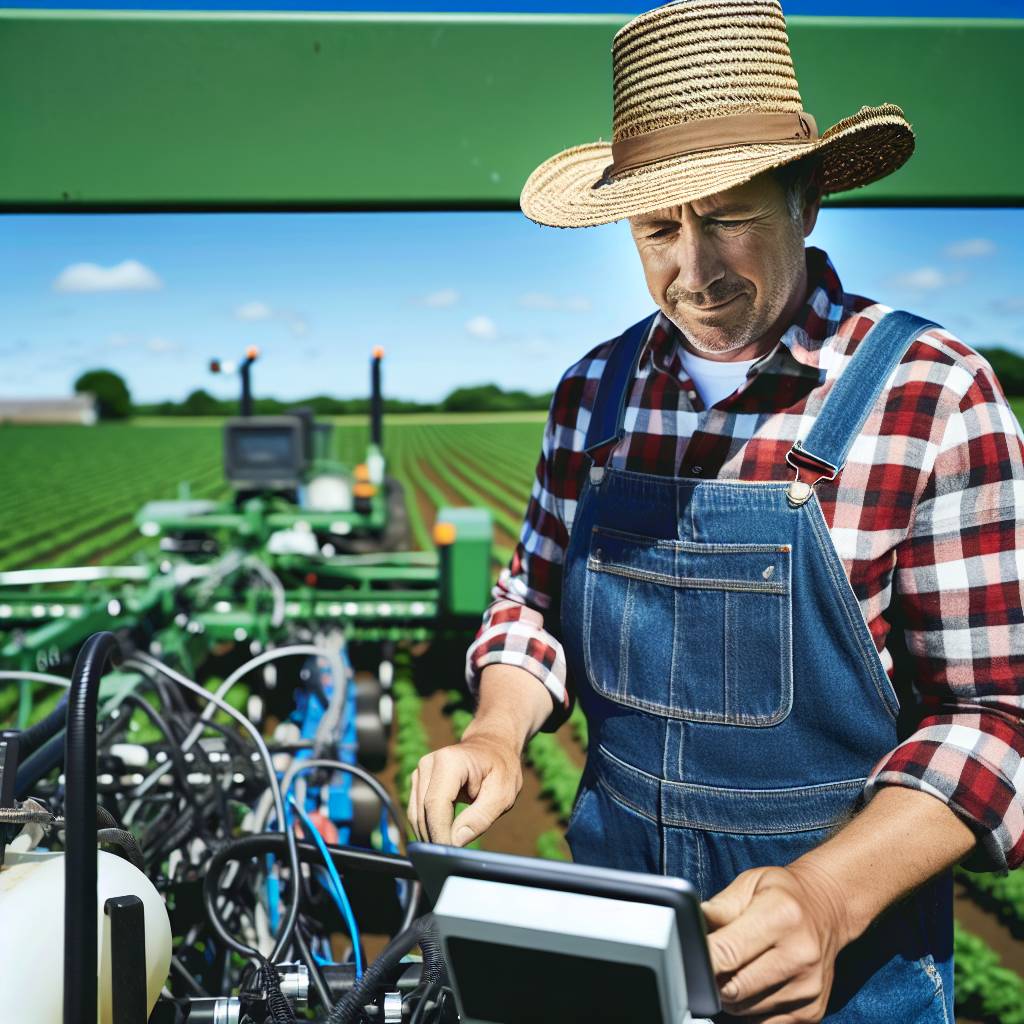
Case Studies: Successful Implementations of Automated Machinery
Innovative Techniques at Green Valley Farms
Green Valley Farms adopted automated machinery to enhance efficiency.
Showcase Your Farming Business
Publish your professional farming services profile on our blog for a one-time fee of $200 and reach a dedicated audience of farmers and agribusiness owners.
Publish Your ProfileThe farm implemented autonomous tractors with GPS-guided technology.
This technology improved planting accuracy and reduced waste.
As a result, crop yields increased by 20% over three years.
Farm management noted a significant reduction in labor costs.
This success led to further investments in automation tools.
Transforming Operations at Sunny Acres Orchard
They used drones for crop monitoring and health assessment.
The drones provided real-time data on plant conditions.
Consequently, farmers made informed decisions regarding irrigation.
This strategy minimized water usage while maximizing yield.
Harvesting automation further streamlined orchard operations.
Boosting Output at Harvest Time Farms
Harvest Time Farms integrated robotic systems into their workflow.
These robots performed repetitive tasks with precision and speed.
Automation significantly reduced the time needed for harvesting.
Farmers reported a decrease in fruit loss during collection.
This innovation led to a notable increase in overall production.
The success encouraged neighboring farms to explore similar technologies.
Improving Sustainability at EcoFarm Solutions
EcoFarm Solutions focused on sustainable farming practices.
They utilized automated irrigation systems to conserve resources.
These systems worked based on real-time data from soil sensors.
Through this method, water usage dropped by 30%.
Additionally, crop yields improved as irrigation became more efficient.
This case demonstrates the potential for agriculture and sustainability.
Uncover the Details: Benefits of Automated Irrigation Systems in Agriculture
Challenges and Limitations of Automated Agriculture
High Initial Costs
Automated machinery requires significant upfront investment.
Farmers may struggle to afford the technology.
In addition, ongoing maintenance costs can be high.
Budget constraints can limit adoption rates.
Technical Complexity
Automated systems can be technically complex to operate.
Farmers need specialized training to manage these tools.
Technological advancements often require continuous learning.
This learning curve can be a barrier for some.
Dependence on Technology
Automation increases reliance on technology for farming tasks.
Any malfunction can disrupt entire operations.
Farmers may feel less control over their processes.
This dependence creates vulnerability in agricultural practices.
Data Security and Privacy Concerns
Agricultural automation relies heavily on data collection.
Farmers must protect sensitive information from breaches.
Data privacy regulations can complicate technology use.
Ensuring data security requires ongoing management and vigilance.
Showcase Your Farming Business
Publish your professional farming services profile on our blog for a one-time fee of $200 and reach a dedicated audience of farmers and agribusiness owners.
Publish Your ProfileEnvironmental Impact
Automated machinery may lead to overreliance on chemicals.
Excessive use can harm local ecosystems and biodiversity.
Farmers need to incorporate sustainable practices into automation.
Balancing efficiency and environmental stewardship is crucial.
Lack of Customization
Many automated systems are designed for generic applications.
This lack of customization can limit effectiveness on different farms.
Farmers may struggle to adapt solutions to their specific needs.
Tailoring technology often requires additional investment.
Future Trends in Automated Machinery and Crop Production
Advancements in Technology
Automated machinery is evolving rapidly in agriculture.
Farmers now use advanced technologies like AI and robotics.
These innovations drive precision farming techniques.
Consequently, farmers experience increased efficiency in their operations.
Integration of IoT Solutions
The Internet of Things (IoT) is becoming prominent in agriculture.
Sensors collect real-time data from fields.
This data helps farmers monitor crop health more effectively.
Moreover, automated irrigation systems optimize water usage.
Environmental Sustainability
Automation promotes environmentally friendly farming practices.
Machines reduce the need for chemical inputs.
As a result, soil health improves over time.
Additionally, farmers can implement crop rotation more efficiently.
Improved Crop Management
Automation enhances crop management techniques significantly.
Farmers can track growth stages with precision tools.
Furthermore, predictive analytics can forecast yields accurately.
This proactive approach helps mitigate potential losses.
Rising Investment and Adoption
Investment in agricultural automation is increasing globally.
Many startups are developing cutting-edge agricultural technologies.
Established companies are also expanding their product lines.
Consequently, adoption rates of automated machinery are rising.
Enhancing Labor Efficiency
Automated machinery helps reduce labor shortages in farming.
Machines can perform menial tasks with greater speed.
This efficiency frees up human labor for more complex tasks.
Farmers thus maximize productivity and profitability.
Additional Resources
Enhancing smart farming through the applications of Agriculture 4.0 …
The Environmental Benefits of Precision Agriculture Quantified …

